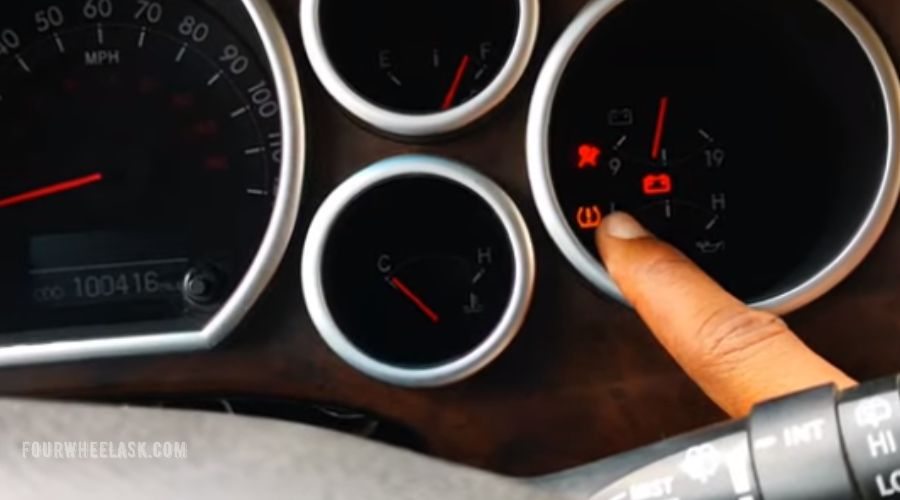Tire Pressure Light Flashes Then Stays On

The dreaded Tire Pressure Monitoring System (TPMS) light. A constant beacon on the dashboard, but even more concerning is when it flashes before illuminating steadily. This behavior isn't a simple under-inflation issue; it usually signals a deeper problem within the TPMS itself. Understanding the nuances of this fault is crucial for automotive professionals to diagnose and repair effectively.
Understanding TPMS Technology
TPMS, mandated in the US since 2007, comes in two main flavors: direct and indirect. Direct TPMS utilizes pressure sensors inside each wheel, transmitting pressure and temperature data wirelessly to a central control unit, typically the Body Control Module (BCM) or a dedicated TPMS ECU. These sensors usually operate on a radio frequency, often 433 MHz in North America and Europe, but frequencies can vary globally. The sensor itself consists of a pressure transducer, temperature sensor, microcontroller, and a battery. Indirect TPMS, on the other hand, relies on the vehicle's ABS (Anti-lock Braking System) to monitor wheel speeds. A deflated tire has a smaller rolling radius, causing it to spin faster than other wheels. The ABS system detects this discrepancy and triggers the TPMS light.
Flashing Light: A System Malfunction
A flashing TPMS light, followed by a solid illumination, almost invariably indicates a system malfunction, not just low tire pressure. This is usually due to one of the following reasons:
- Sensor Failure: One or more TPMS sensors may have failed, either due to battery depletion, physical damage, or electronic component failure. Sensor batteries typically last 5-10 years, depending on usage and environmental conditions.
- Communication Issues: Interference, a faulty receiver module, or a damaged wiring harness can disrupt communication between the sensors and the TPMS ECU. Electromagnetic interference (EMI) from aftermarket electronics can sometimes cause problems.
- Incorrect Sensor ID: After a tire rotation, sensor replacement, or wheel swap, the TPMS ECU may not recognize the sensor IDs. Re-learning procedures are required to register the new sensor IDs.
- ECU Malfunction: Although less common, the TPMS ECU itself can fail, leading to erratic behavior.
Troubleshooting and Diagnostics
A systematic approach to diagnosing a flashing TPMS light is critical:
- Diagnostic Scan: Use a scan tool capable of reading TPMS data. This will reveal diagnostic trouble codes (DTCs) related to sensor faults, communication errors, or ECU problems. Pay close attention to codes that specifically mention "sensor communication error," "invalid sensor ID," or "ECU malfunction."
- Sensor Activation: Most advanced scan tools can activate individual TPMS sensors and display their pressure, temperature, and battery status. This helps pinpoint faulty sensors.
- Visual Inspection: Check the sensors for physical damage, corrosion, or loose connections. Inspect the wiring harness and connectors for damage or corrosion.
- Re-learning Procedure: If sensors have been recently replaced or the wheels have been rotated, perform the TPMS re-learning procedure. This can usually be done through the scan tool or, in some cases, through a series of steps involving the ignition and accelerator pedal (consult the vehicle's service manual).
- Verify Compatibility: Ensure that any replaced sensors are compatible with the vehicle's TPMS system. Using incorrect sensors can lead to communication problems and a flashing light.
Direct vs. Indirect TPMS: Pros and Cons
Direct TPMS offers more accurate pressure readings and can detect slow leaks more effectively. However, it's more expensive to maintain due to sensor replacement costs and requires specialized tools for programming and diagnostics. Indirect TPMS is less accurate and cannot detect slow leaks as reliably. Its accuracy is also affected by factors like tire wear and road conditions. However, it's less expensive and doesn't require sensor replacement or specialized programming tools. The choice between the two often comes down to cost versus performance.
Reliability and Maintenance
TPMS sensors are generally reliable, but their battery life is limited. Regular tire maintenance, including proper inflation and rotation, can extend sensor lifespan. Avoid using tire sealants that contain corrosive chemicals, as they can damage the sensors. When replacing tires, consider replacing the TPMS sensors as a preventative measure, especially if they are approaching the end of their expected lifespan. Always use OEM or high-quality aftermarket sensors to ensure compatibility and reliability.
Future Trends in TPMS Technology
Future TPMS systems are likely to become more integrated with other vehicle systems, such as advanced driver-assistance systems (ADAS). Expect to see more sophisticated sensors that can provide additional data, such as tire tread depth and road surface conditions. Remote diagnostics and over-the-air software updates for TPMS ECUs are also likely to become more common. The industry is also moving towards more standardized sensor protocols to improve interoperability and reduce costs.
Conclusion
The automotive industry is rapidly evolving, with a growing emphasis on vehicle safety and efficiency. Understanding the complexities of systems like TPMS is crucial for automotive professionals to stay ahead of the curve. By adopting a systematic approach to diagnostics, staying informed about the latest technologies, and providing proactive maintenance, we can ensure the safety and reliability of the vehicles we service. As vehicles become more complex and interconnected, lifelong learning and adaptation are key to success in the automotive repair industry.
